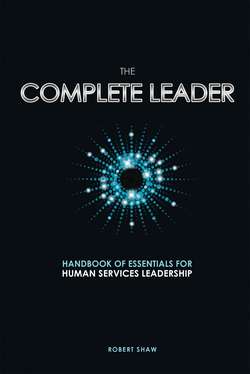Читать книгу The Complete Leader - Robert Shaw B. - Страница 6
На сайте Литреса книга снята с продажи.
ОглавлениеChapter 1 - Leadership in the Voluntary Services Organization
It is a pleasure to reflect on the nature of the voluntary organization and its leadership. It is a comfort to remember that in our society human services are in the hands of communities of volunteers, despite the ever presence of money madness in our world. Human services have their origins in the voluntary organizations. Their service purposes have not changed with time.
The mission of the organization is the cornerstone of leadership. Mission identifies those to be served, their special needs and the desired results.
The essence of leadership is enabling others to perform to their full capacity and satisfaction. And the very essence of the essence is trust.
In Canada, the beneficiaries of our human services number in the millions. Their special challenges range from a child adjusting to school to marital tension to spiritual confusion. The voluntary sector is blessed with highly competent volunteers and professionals.
From a cursory view of the organization, it is apparent that leadership is exercised at different levels in the human services organization.
There are at least four leadership levels:
• The board of directors holds total responsibility for policy, finance and community relations.
• The senior management level is responsible for the total operation.
• At the program level, the focus is on specific services.
• Responsibility for the welfare of the client is found at the direct service level.
With leadership operating at different levels with different roles, there is a need for common elements of leadership style. Incompatible styles lead to confusion and diminished services.
The first common element of leadership is a balance between the human relations and the performance sides of leadership. Some leaders favor the human relations side of leading; others prefer a “getting the job done” style. A balance is required. Too great a reliance on one style leads to service ineffectiveness.
Here is a real-life experience of contrasts in leadership styles.
James was the principal of a training college for leaders. He was posted to a local church congregation in western Ontario to become the lead clergyman. When meeting with the church council, James explained that he brought a good knowledge of leadership literature but no experience as a congregation leader.
James then took the unusual position that he would try no direct leadership efforts. He pointed out that the council members understood the congregation better than he ever would. He reserved the right of approval of council decisions. James would not attempt any service initiatives but would leave those responsibilities with the council members.
In taking that stand, James showed his trust of the council and relegated his role to mainly a coach. He provided a balanced sense of responsibility and caring in his leadership.
After five years, James was posted elsewhere. At the time of his leaving, that congregation was known for having the strongest lay leadership in the denomination.
Paul became the new church leader—a dear man who took his clerical responsibilities very seriously. This led him into a very active role in all aspects of the congregation. His style was micro management. Within a matter of months, leadership activities of the council had diminished to their earlier dormant state.
The essence of leadership is enabling others to serve at their full potential.
A balance must be achieved between the human relations and performance sides of others.
Leaders come with motivation, knowledge and skills from their previous service and training. In most cases the leader instinctively favors the human relations side of leadership. Within the voluntary organization, however, these instincts must operate within a common leadership framework. That framework includes such processes as delegation, supervision and teamwork. People working together for a common purpose must appreciate each other’s interpersonal and organizational styles.
It is no small task for a leader trained in one profession to adjust to other professions in order to achieve common organizational styles. This knowledge cannot come from books and courses. The leader must learn as she goes with a new focus on the best combination of professional and organizational practices, rather than those from her own profession. This learning and transition comes from experience on the job.
On the performance side, the adjustments to organization frameworks are even more demanding. Just imagine the steps needed to arrive at a common understanding of recording and statistical methods of performance and accountability for both a social worker and an information systems person. Yet the client needs to experience consistency of practices from the organization.
Fortunately, the voluntary human service organization has an acid test for its definitions of good human relations and helpful performance styles. As with any question, the answer is found in the mission.
What shapes the nature and character of the organization is what works for the client. Human relations styles for the client shape the human relations styles of the organization. Performance styles helpful to clients shape the performance practices of the organization.
If Paul had pondered his best counseling styles with his new parishioners, he could then have seen how he should have led.
Keys to Leadership
The leader is a coach who:
• Encourages working together with a common vision.
• Helps direct individual accomplishments toward organization objectives.
• Enables common people to attain uncommon results.
